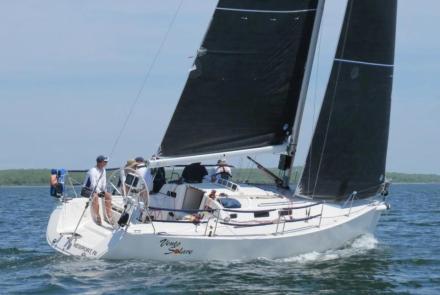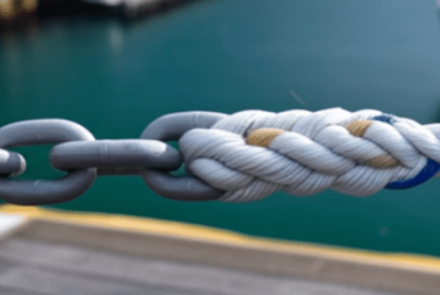A Seamanship Ethos
Adapted from the foreword to the 4th edition, The Annapolis Book of Seamanship,
“The art of sailing, maneuvering, and preserving a ship or a boat in all positions and under all reasonable circumstances.” This classic definition of “seamanship” has guided the preparation of this book for 30 years through four editions. Much has changed in boats, sails, and electronics, but with the addition of these words, “and some unreasonable circumstances, too,” that definition is as valid and essential today as it was in 1983.
Our concern as a community is what we sailors should know and should do as we engage with boats and the craft of handling them ably and safely.
For all the technology of sailing, for all its theories and skills and high-tech equipment, for all its dreams of glory, what sustains this sport that is much more than a sport – this pastime – alive is the depth of feeling that men and women sailors feel share the water and for boats. Rear Admiral Robert W. McNitt wrote in his history of sailing at the U.S. Naval Academy that for all the time he had spent in naval vessels, the true meaning of the sea – and the source of his passion for it – first became clear to him in a sailboat race, when he as a young ensign raced to Bermuda. “Like human attachments, this romance cannot be taught or forced,” he affirmed. “It comes gently during a midwatch in the soft warm moonlight of the Gulf Stream, in the crashing roar of a sudden squall, and in the dawn of a new day at sea. It comes most easily and naturally under sail.”
The fact that you’re reading this website indicates that you don’t have to be told about the lure of wind, water, and boats
The fact that you’re reading this website indicates that you don’t have to be told about the lure of wind, water, and boats. You may, like me, have a vivid memory of stepping into a boat for the first time. In my case it was at the age of eight at a summer camp on the Kennebec River in Maine. Perhaps you, also like me, were enchanted and also a little dismayed by how strange it all seemed, with the unfamiliar equipment and the strange language (what, exactly, is the difference between a “jib” and a “jibe,” between “leeway” and a “leeboard”?).
As I began to love that strangeness and the challenges that came with boats and the water, I realized that I wasn’t alone. My father was a lifelong sailor. The beatific look on his face when he took the helm in any boat indicates how much he adored all this, with the joys and the challenges all rolled into the one magnetic, enchanting object that is the boat. That intense, spiritual commitment was shared by a friend and sometime competitor of my dad’s, Cornelius Shields. Corny Shields came later to sailing than I did, and his conversion occurred when he was handed the tiller. “It didn’t take 20 seconds before I was hit by a welling-up of emotion so strong it’s almost indescribable. It was like a theater curtain going up. Suddenly, I was tremendously happy. . . . Never, before or since, has anything opened up to me so spectacularly.” The man was totally transformed.
We are all familiar with these feelings, aren’t we? The first sail, the first voyage, the first grasp of the tiller – such moments mean so much more than learning a racing tactic or how to trim a spinnaker. Nicholas Hayes, the author of Saving Sailing, has described a day in a typical Chicago to Mackinac Race as “a day of transcendence and transformation; sailors will tell you that every person who starts this race will finish as someone new.”
Seamanship is an attitude, an ethos, and a quest that guides us, if we are willing – sometimes pulling, sometimes pushing – in the right direction.
Joseph Conrad, the finest of all sailing writers, and himself an experienced seaman, called the community of sailors “our fellowship in the craft and the mystery of the sea.” We all know what that “mystery” is: it’s the entrancing, even addictive experience behind my father’s smile and Corny Shields’ exuberance. E.B. White put his finger on that mystery when he wrote, “I cannot not sail.” As for the “craft” that Conrad referred to – that is seamanship. It’s an ever expanding set of skills, and much more. Seamanship is an attitude, an ethos, and a quest that guides us, if we are willing – sometimes pulling, sometimes pushing – in the right direction. Seamanship is both a technical discipline that you will never stop mastering, and a caring, alert, cautious, and even slightly anxious state of mind we must never cease developing and improving.
Long ago a pioneer cruising sailor, Richard T. McMullen, compared the mixed joys and discomforts of sailing a boat with picking roses off a thorny bush. There is the occasional bloody finger, yes indeed there is. Our calling as sailors is to attempt to master, and continue to preach, the skills and attitudes of seamanship that help identify those thorns and avoid them – in other words to be a sailor who is better, safer, and also happier because we know the thorns are there, alongside the roses.
We are never safe at sea, whether we are professionals or amateurs
After a series of accidents in 2011 and 2012, a sailor asked this question in Scuttlebutt, a sailors’ blog: “How does the average sailor get enough experience to be safe at sea?” In reply, CCA member Brad Avery, Director of the Orange Coast College Sailing and Seamanship Program in Newport Beach, Cal., said that the premise that there can be “enough” experience is mistaken. “We are never safe at sea, whether we are professionals or amateurs. We are always one bad decision away from disaster. My goal is to sail error-free on each cruise or race, but I know this is impossible to achieve. The quest for a voyage free of mistakes goes on. Time on the water, training, humility, and constant vigilance are the keys to being ‘safer.’”
Brad concluded with these wise words: “Knowing you’re never safe also helps.”
Thoughts like this run throughout maritime history. Joseph Conrad expressed the idea a little differently: “A seaman laboring under an undue sense of security becomes at once worth hardly half his salt.” Herman Melville in Moby-Dick observed that the good mariner “feels just enough of trepidation to sharpen all his faculties.” This applies to racers and to cruisers alike. The best racing sailors I know are deeply concerned about seamanship and safety. “Safety and performance are not mutually exclusive,” says an able racing sailor with whom I have sailed many miles, Howard Lapsley.
Let me end by repeating the wish I extended 30 years ago on the first page of the first edition of The Annapolis Book of Seamanship: “May your days and nights afloat be as happy and interesting as mine have been, and may you never make the mistake of believing that you know all there is about sailing. Nobody knows it all. Nobody can know it all, but here (I hope) you will learn at least a little.”




